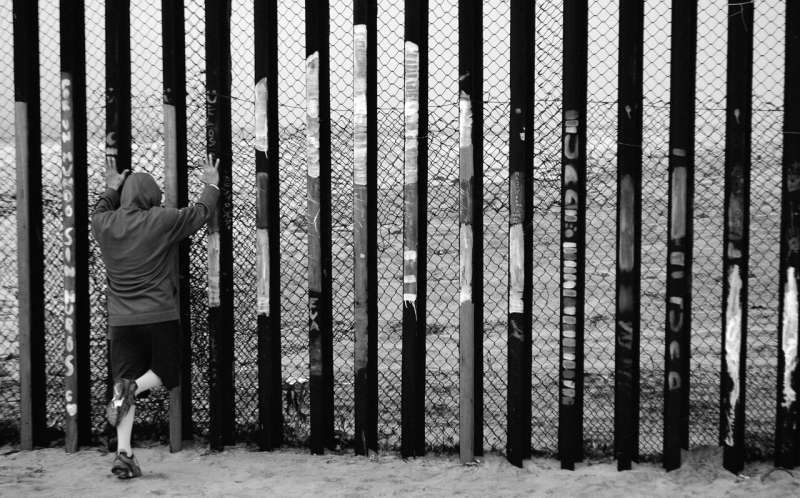
The border crossing separating San Diego, California, from Tijuana, Mexico, is a dynamic place. When it was closed during the COVID-19 pandemic, drug tourism from San Diego to Tijuana continued. This provided a flow of people in both directions, bringing with them not only the virus that causes COVID-19 (SARS-CoV2) but also the virus that causes AIDS (HIV).
A collaborative study led by researchers from University of California San Diego and Irvine, published in The Lancet Regional Health—Americas, found that rather than preventing the spread of disease, closing the border actually increased the rate of HIV transmission.
Injection drug use increases the risk of HIV infection through the sharing of injection equipment. To investigate the dynamics between border closure, drug use and HIV transmission, Britt Skaathun, Ph.D., adjunct assistant professor at UC San Diego School of Medicine, and first author on the paper, led an effort that studied 618 participants from October 2020 to October 2021, focusing on three different groups: people who live in San Diego who cross the border to use drugs in Tijuana; people who live in San Diego and use drugs in San Diego; and people who live in Tijuana and use drugs in Tijuana.
Subjects first underwent interviews, answering questions about their demographics, drug use behaviors, sexual behaviors, sexual identity and border crossing behaviors. Every six months they gave blood samples and were tested for HIV and hepatitis C.
Tetyana Vasylyeva, D.Phil., assistant professor of population health and disease prevention at UC Irvine, and senior author on the study, analyzed the spread of HIV through the virus genetic data.
Combining molecular epidemiology with the questionnaire answers, the scientists found that people were crossing the border in both directions and being exposed to HIV despite government efforts to keep the border closed. The scientists then deepened their analysis by applying advanced molecular techniques.
For every patient who tested HIV positive, Vasylyeva and her colleagues isolated the virus, sequenced its RNA and analyzed the genetic diversity in the border region. They investigated how closely the viruses were related genetically—a field of study called phylogenetics, in which scientists construct trees representing how viruses relate to each other.
After constructing viral phylogenetic trees, the scientists subjected them to a molecular clock analysis. Molecular clock is based on a theory that assumes organisms evolve with a relatively constant rate over time. In this case, applying the molecular clock to the phylogenetic trees enabled the scientists to estimate the timing of cross-border HIV transmission. That further enabled them to identify transmission clusters.
“If two or three people have viruses that are very similar to each other, we can assume that the transmission event happened more recently, because there is not enough evolution between these different viruses from these different people,” explained Vasylyeva.
The next step was to combine the survey data and the phylodynamic data. They found that during the 18-month period of their study, nine people contracted HIV, mostly during the pandemic.
“Nine sounds like a small number, but it’s actually quite a lot of people because in the U.S., HIV incidence is relatively low. We were surprised to see this change in HIV status in such a short amount of time and wanted to look more closely at these clusters,” said Skaathun.
Applying a molecular clock to the clusters, they found a surprise: all of the new clusters had sequences from participants on both sides of the border, indicating that cross-border transmission was happening right when the border was closed. One cluster that grew despite the border closure included two people from San Diego that used drugs in Tijuana.
“This shows that efforts to build a higher wall or policies to stop immigration will not mitigate HIV spread,” said Vasylyeva.
Structural risk is a social factor that increases harm. Skaathun says the current study shows that closing the border during the pandemic functioned as a structural risk factor.
“The Frontera [border] is one integrated community that is not defined by place of residence. Efforts to end the HIV epidemic in the U.S. also need to be integrated by extending to Tijuana,” she said.
In 2000, the U.S.-Mexico Border Health Commission was founded to “provide international leadership to improve health and quality of life along the U.S.-Mexico border.” Gudelia Rangel, Ph.D., serves as executive secretary for the commission. Rangel is also a co-author on the current study.
“These findings confirm that HIV has no passport,” she says. Like her colleagues, she believes that establishing programs to eliminate HIV transmission at the border, such as harm reduction and substance use treatment services, is a more effective way of preventing viral spread than attempting to close a porous border.
More information:
Britt Skaathun et al, HIV-1 transmission dynamics among people who inject drugs on the US/Mexico border during the COVID-19 pandemic: a prosepective cohort study, The Lancet Regional Health—Americas (2024). DOI: 10.1016/j.lana.2024.100751
Citation:
Closing the US/Mexico border during COVID-19 increased HIV transmission, study finds (2024, May 1)
retrieved 4 May 2024
from https://medicalxpress.com/news/2024-05-usmexico-border-covid-hiv-transmission.html
This document is subject to copyright. Apart from any fair dealing for the purpose of private study or research, no
part may be reproduced without the written permission. The content is provided for information purposes only.

